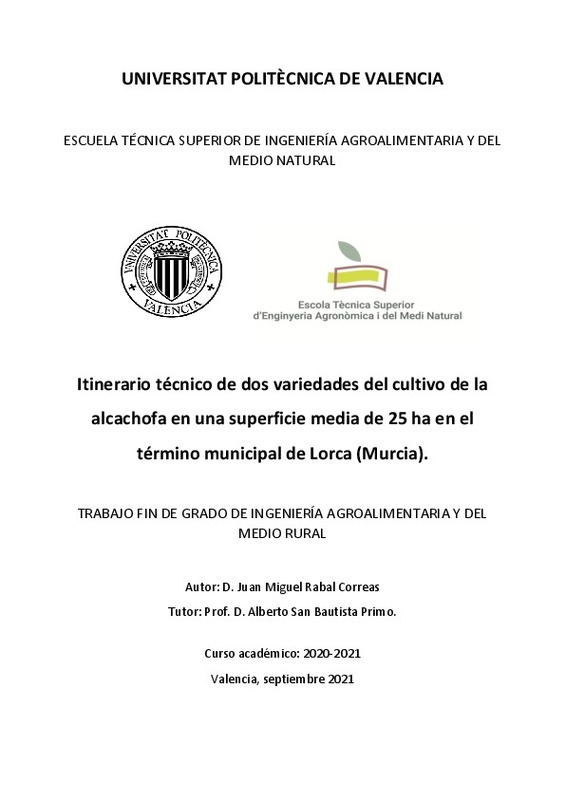JavaScript is disabled for your browser. Some features of this site may not work without it.
Buscar en RiuNet
Listar
Mi cuenta
Estadísticas
Ayuda RiuNet
Admin. UPV
Itinerario técnico de dos variedades del cultivo de la alcachofa en una superficie media de 25 ha en el término municipal de Lorca (Murcia)
Mostrar el registro sencillo del ítem
Ficheros en el ítem
| dc.contributor.advisor | San Bautista Primo, Alberto
|
es_ES |
| dc.contributor.author | Rabal Correas, Juan Miguel
|
es_ES |
| dc.coverage.spatial | east=-1.6968357; north=37.6735925; name=M8F3+C7 Llorca, Espanya | es_ES |
| dc.date.accessioned | 2021-12-30T15:40:09Z | |
| dc.date.available | 2021-12-30T15:40:09Z | |
| dc.date.created | 2021-12-14 | |
| dc.date.issued | 2021-12-30 | es_ES |
| dc.identifier.uri | http://hdl.handle.net/10251/179184 | |
| dc.description.abstract | [ES] España es el segundo país productor de alcachofa en el mundo. Su producción está concentrada a lo largo de la Costa Mediterránea y del Valle del Ebro, siendo el área principal de producción La Región de Murcia, con un 40 % de la superficie total. Dentro de la provincia de Murcia, las zonas con mayores producciones son el Valle del Guadalentín y el Campo de Cartagena. Debido a la importancia del cultivo en la zona del Valle del Guadalentín, se ha decidido realizar este TFG, centrado tanto en la parte agronómica como en la económica de dos variedades de alcachofa:el cv. Blanca de Tudela, propagada vegetativamente, el cv. Green Queen propagada por semilla. Agronómicamente, hay diferencias notables entre estos dos grupos de variedades y resulta de especial interés su estudio. Para determinar las diferencias entre ambas variedades, se realizará un itinerario de cultivo propio de cada una de ellas, donde se pondrán de manifiesto todas las labores agrícolas, materias primas, mano de obra y sus respectivos precios, para finalmente conocer tanto los costes como los ingresos, y observar cuál de las dos variedades es más rentable desde el punto de vista económico. Los precios y datos que serán contrastados a lo largo del trabajo han sido obtenidos gracias a entrevistas con técnicos y documentos facilitados por la empresa Cricket Campo de Lorca S.L. El análisis económico será realizado en una superficie conocida de 25 ha en el término municipal de Lorca (Murcia), superficie que se considera como media, según los datos de la empresa. | es_ES |
| dc.description.abstract | [EN] Spain is the second largest artichoke producing country in the world. Its production is concentrated along the Mediterranean Coast and the Ebro Valley, being the main area of production The Region of Murcia, with 40% of the total area. Within the province of Murcia, the areas with the highest productions are the Guadalentín Valley and the Campo de Cartagena. Due to the importance of cultivation in the Guadalentín Valley area, it has been decided to carry out this TFG, focused on both the agronomic and economic part of two varieties of artichoke: the cv. Blanca de Tudela, vegetatively propagated, the cv. Green Queen propagated by seed. Agronomically, there are notable differences between these two groups of varieties and their study is of special interest. To determine the differences between the two varieties, a cultivation itinerary will be carried out for each of them, where all agricultural work, raw materials, labour and their respective prices shall be revealed, to finally know both the costs and the income, and observe which of the two varieties is more profitable from the economic point of view. The prices and data that will be contrasted throughout the work have been obtained thanks to interviews with technicians and documents provided by the company Cricket Campo de Lorca S.L. The economic analysis will be carried out in a known area of 25 ha in the municipality of Lorca (Murcia), area that is considered as average, according to the company's data. | es_ES |
| dc.format.extent | 75 | es_ES |
| dc.language | Español | es_ES |
| dc.publisher | Universitat Politècnica de València | es_ES |
| dc.rights | Reserva de todos los derechos | es_ES |
| dc.subject | Multiplicación vegetativa | es_ES |
| dc.subject | Semillas | es_ES |
| dc.subject | Alcachofa | es_ES |
| dc.subject | Itinerario de cultivo | es_ES |
| dc.subject | Explotación agrícola | es_ES |
| dc.subject | Estudio económico | es_ES |
| dc.subject | Vegetative multiplication | es_ES |
| dc.subject | Seeds | es_ES |
| dc.subject | Artichoke | es_ES |
| dc.subject | Cultivation itinerary | es_ES |
| dc.subject | Farm | es_ES |
| dc.subject | Economic study | es_ES |
| dc.subject.classification | PRODUCCION VEGETAL | es_ES |
| dc.subject.other | Grado en Ingeniería Agroalimentaria y del Medio Rural-Grau en Enginyeria Agroalimentària i del Medi Rural | es_ES |
| dc.title | Itinerario técnico de dos variedades del cultivo de la alcachofa en una superficie media de 25 ha en el término municipal de Lorca (Murcia) | es_ES |
| dc.type | Proyecto/Trabajo fin de carrera/grado | es_ES |
| dc.rights.accessRights | Abierto | es_ES |
| dc.contributor.affiliation | Universitat Politècnica de València. Departamento de Ingeniería Rural y Agroalimentaria - Departament d'Enginyeria Rural i Agroalimentària | es_ES |
| dc.contributor.affiliation | Universitat Politècnica de València. Escuela Técnica Superior de Ingeniería Agronómica y del Medio Natural - Escola Tècnica Superior d'Enginyeria Agronòmica i del Medi Natural | es_ES |
| dc.description.bibliographicCitation | Rabal Correas, JM. (2021). Itinerario técnico de dos variedades del cultivo de la alcachofa en una superficie media de 25 ha en el término municipal de Lorca (Murcia). Universitat Politècnica de València. http://hdl.handle.net/10251/179184 | es_ES |
| dc.description.accrualMethod | TFGM | es_ES |
| dc.relation.pasarela | TFGM\145338 | es_ES |
Este ítem aparece en la(s) siguiente(s) colección(ones)
-
ETSIAMN - Trabajos académicos [3541]
Escuela Técnica Superior de Ingeniería Agronómica y del Medio Natural






